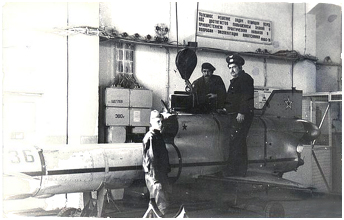
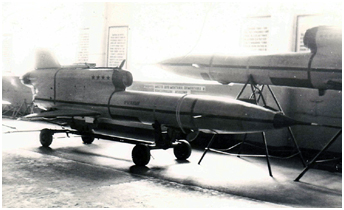 In addition to the aviation units equipped with reconnaissance aircraft, the Group of Soviet Forces in Germany also had reconnaissance drones on strength beginning in the late 1970s.
The drone squadrons were successively subordinated to the 16.VA, to the headquarters of each ground army, and finally again to the 16.VA. This type of recce platform then provided greater precision
in intelligence gathering than the aircraft of the time, the MiG-21R and the Yak-28R.
In addition to the aviation units equipped with reconnaissance aircraft, the Group of Soviet Forces in Germany also had reconnaissance drones on strength beginning in the late 1970s.
The drone squadrons were successively subordinated to the 16.VA, to the headquarters of each ground army, and finally again to the 16.VA. This type of recce platform then provided greater precision
in intelligence gathering than the aircraft of the time, the MiG-21R and the Yak-28R.
The five separate drone reconnaissance squadrons (OEBSR - Otdel'naya Eskadril'ya Bespilotnikh Samoletov-Razvedchikov) in the GDR were equipped with Tupolev Tu-143 reconnaissance drones
(> Link).
Unfortunately, there is no accessible information or known testimony to confirm or deny that the predecessor of the Tu-143, namely the Lavochkin La-17R - TBR-1 complex -
(> Link) that was introduced into service in the mid-sixties, previously was operational with the GSFG.
One can nevertheless imagine that if this was the case, the three Western military liaison missions or Western wiretapping services would have ended up observing them as was the case for the Tu-143.
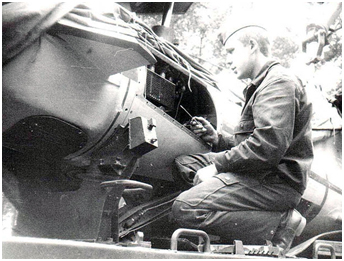
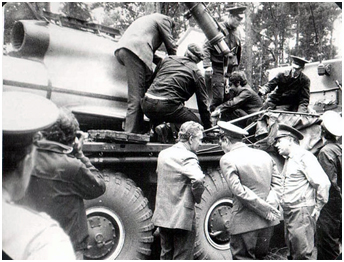 Based on the experience gathered with the extraordinary Tu-123 - DBR-1 Yastreb (Falcon) complex - long-range reconnaissance drones
(> Link), in the mid-sixties Tupolev's OKB-156 began to develop a new reconnaissance system
designated VR-3 Reys (Flight) comprising the Tu-143 drone.
The specifications required in particular that the aircraft could fly at high and low altitude (from 50 to 5000 meters - apparently under operational conditions, from 100 to 3000 meters)
including in mountainous terrain, it required a limited radar signature and it had to be recovered in an area equivalent to a square with a side of 500 meters (or 700 meters depending on the sources).
The first flight of a Tu-143 took place in December 1970 and the official tests ended in 1976. The system was officially adopted by the Soviet Army in 1982, although it started
to be used earlier as during Exercise "Zapad 81."
However, as early as 1972, the first batch of ten drones was built at the Kumertau plant in Bashkiria, after which series production began and went on until 1989 when it ended
after 950 units were assembled (the Reys complex also was exported to Czechoslovakia, Romania, and Syria where it experienced combat
above Lebanon).
Based on the experience gathered with the extraordinary Tu-123 - DBR-1 Yastreb (Falcon) complex - long-range reconnaissance drones
(> Link), in the mid-sixties Tupolev's OKB-156 began to develop a new reconnaissance system
designated VR-3 Reys (Flight) comprising the Tu-143 drone.
The specifications required in particular that the aircraft could fly at high and low altitude (from 50 to 5000 meters - apparently under operational conditions, from 100 to 3000 meters)
including in mountainous terrain, it required a limited radar signature and it had to be recovered in an area equivalent to a square with a side of 500 meters (or 700 meters depending on the sources).
The first flight of a Tu-143 took place in December 1970 and the official tests ended in 1976. The system was officially adopted by the Soviet Army in 1982, although it started
to be used earlier as during Exercise "Zapad 81."
However, as early as 1972, the first batch of ten drones was built at the Kumertau plant in Bashkiria, after which series production began and went on until 1989 when it ended
after 950 units were assembled (the Reys complex also was exported to Czechoslovakia, Romania, and Syria where it experienced combat
above Lebanon).
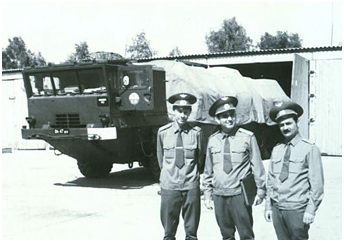
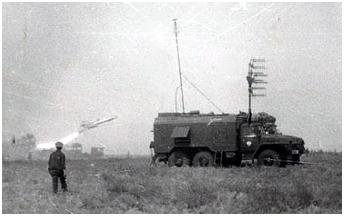 In addition to the Tu-143s themselves, the VR-3 complex included the vehicles necessary for their implementation, their reconditioning for a new launch, and the analysis of the information collected.
These were mainly TZM-143 drone carriers (BAZ-135MB prime movers > Link),
SPU-143 mobile launchers (> Link), a KPK-143 complex composed of three test and maintenance vehicles - an APA-50M generator set mounted on a ZiL-131 chassis
(> Link) and two KIPS-1 and KIPS-2 (Kontrol'no-Proverochniye Stantsii) mobile control and test stations -
and finally a POD-3 information processing unit (photo and video development and interpretation, radiation analysis, and transmission of information to consumers).
Four VR-3 complexes were assigned to each squadron, which represented a total of twelve Tu-143 (four drone carriers with two Tu-143 each and four launchers with one drone each).
In addition, one or more UAZ-452T-2 vans (Topoprivyazchik - Topographer) intended to record the geographical coordinates
of the site before launch (> Link 1 / > Link 2)
accompanied the squadron, as well as one or two AA-40 type firefighting vehicles
(chassis ZiL-131 > Link).
Added to this were the resupply vehicles needed for fuel, oil, compressed air, etc.
A squadron was likely to (re)deploy within a radius of 500km.
In addition to the Tu-143s themselves, the VR-3 complex included the vehicles necessary for their implementation, their reconditioning for a new launch, and the analysis of the information collected.
These were mainly TZM-143 drone carriers (BAZ-135MB prime movers > Link),
SPU-143 mobile launchers (> Link), a KPK-143 complex composed of three test and maintenance vehicles - an APA-50M generator set mounted on a ZiL-131 chassis
(> Link) and two KIPS-1 and KIPS-2 (Kontrol'no-Proverochniye Stantsii) mobile control and test stations -
and finally a POD-3 information processing unit (photo and video development and interpretation, radiation analysis, and transmission of information to consumers).
Four VR-3 complexes were assigned to each squadron, which represented a total of twelve Tu-143 (four drone carriers with two Tu-143 each and four launchers with one drone each).
In addition, one or more UAZ-452T-2 vans (Topoprivyazchik - Topographer) intended to record the geographical coordinates
of the site before launch (> Link 1 / > Link 2)
accompanied the squadron, as well as one or two AA-40 type firefighting vehicles
(chassis ZiL-131 > Link).
Added to this were the resupply vehicles needed for fuel, oil, compressed air, etc.
A squadron was likely to (re)deploy within a radius of 500km.
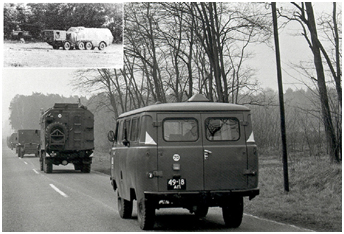
 This daytime reconnaissance drone was powered by an Izotov TR3-117 reactor providing 640kg of thrust that allowed it to fly at a maximum speed of 950 km/h.
A jettisonable SPRD-251 solid-fuel propellant booster assisted the drone's launch at an angle of 15 degrees - the take-off weight reached 1600 kg with this rocket.
The detachable nose cone offered the capability of mounting three separate reconnaissance suites.
On the one hand, there was the traditional photographic reconnaissance complex equipped with a PA-1 panoramic camera (> Link) with 120 meters of film,
on the other, a TV reconnaissance variant composed of the I-429B Chibis-B (Lapwing) suite that transmitted the images by data link to the command posts
(the best shots were obtained from an altitude of 200 meters; moreover their geographical coordinates were also transmitted in real time by radio), and, finally,
a Sigma-R set intended to analyze the degree of radiation in the air with dosimeters. The readings along the flight route were
also retransmitted to the ground by radio link.
It is the ABSU-143 (Avtomaticheskaya Bortovaya Sistema Upravleniya) onboard automatic control system that among other things ensured the stability of the drone according to its center of gravity,
the respect of the flight parameters, triggered the shots or the recording of the coordinates.
Contrary to the Tu-141 developed more or less at the same time (see "Versions, derivatives and cousins" at the bottom of the page), with a range generally limited to 60-70km,
or about 13 minutes of flight, hardly moved far from the battlefield.
This daytime reconnaissance drone was powered by an Izotov TR3-117 reactor providing 640kg of thrust that allowed it to fly at a maximum speed of 950 km/h.
A jettisonable SPRD-251 solid-fuel propellant booster assisted the drone's launch at an angle of 15 degrees - the take-off weight reached 1600 kg with this rocket.
The detachable nose cone offered the capability of mounting three separate reconnaissance suites.
On the one hand, there was the traditional photographic reconnaissance complex equipped with a PA-1 panoramic camera (> Link) with 120 meters of film,
on the other, a TV reconnaissance variant composed of the I-429B Chibis-B (Lapwing) suite that transmitted the images by data link to the command posts
(the best shots were obtained from an altitude of 200 meters; moreover their geographical coordinates were also transmitted in real time by radio), and, finally,
a Sigma-R set intended to analyze the degree of radiation in the air with dosimeters. The readings along the flight route were
also retransmitted to the ground by radio link.
It is the ABSU-143 (Avtomaticheskaya Bortovaya Sistema Upravleniya) onboard automatic control system that among other things ensured the stability of the drone according to its center of gravity,
the respect of the flight parameters, triggered the shots or the recording of the coordinates.
Contrary to the Tu-141 developed more or less at the same time (see "Versions, derivatives and cousins" at the bottom of the page), with a range generally limited to 60-70km,
or about 13 minutes of flight, hardly moved far from the battlefield.
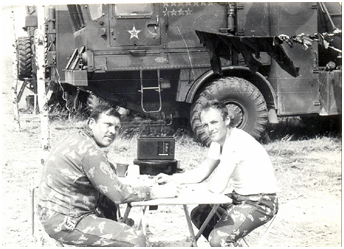
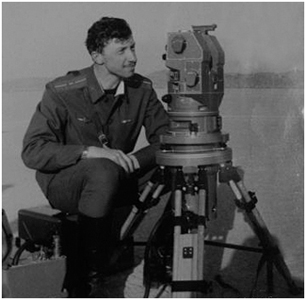 Before a mission, the launch launch vehicle was positioned at a given point determined with equipment designated "Kvadrat" (Square).
A 2T2 theodolite nicknamed "thermometer" (> Link) and a 1G17 gyrocompass
disembarked from an UAZ-452T-2 vehicle were among the equipment used for this purpose. Such equipment also was used by artillery units. We will understand all the better the importance
of this step when we learn that the flight profile that only allowed two turns, was pre-programmed on the ground and then uploaded into the BVD-1 unit of the Tu-143 just before takeoff.
The personnel carrying out the pre-flight tests and initiating the firing sequence were inside the cabin of the SPU-143 launcher (> Link 1 /
> Link 2 /
> Link 3) whose roof was made of fiberglass for strength reasons.
It bore the brunt of the jet of the booster rocket on take-off and was momentarily deformed. A hinged protection plate was previously folded down in front of the windshield,
while two other smaller plates mounted on either side of the radiator in normal times were placed in front of it in order to preserve it during takeoff.
Before landing, the Izotov reactor stopped, and the drone entered a zoom climb to kill its forward speed. A brake chute located inside the fairing at the fin root was then deployed.
Before a mission, the launch launch vehicle was positioned at a given point determined with equipment designated "Kvadrat" (Square).
A 2T2 theodolite nicknamed "thermometer" (> Link) and a 1G17 gyrocompass
disembarked from an UAZ-452T-2 vehicle were among the equipment used for this purpose. Such equipment also was used by artillery units. We will understand all the better the importance
of this step when we learn that the flight profile that only allowed two turns, was pre-programmed on the ground and then uploaded into the BVD-1 unit of the Tu-143 just before takeoff.
The personnel carrying out the pre-flight tests and initiating the firing sequence were inside the cabin of the SPU-143 launcher (> Link 1 /
> Link 2 /
> Link 3) whose roof was made of fiberglass for strength reasons.
It bore the brunt of the jet of the booster rocket on take-off and was momentarily deformed. A hinged protection plate was previously folded down in front of the windshield,
while two other smaller plates mounted on either side of the radiator in normal times were placed in front of it in order to preserve it during takeoff.
Before landing, the Izotov reactor stopped, and the drone entered a zoom climb to kill its forward speed. A brake chute located inside the fairing at the fin root was then deployed.

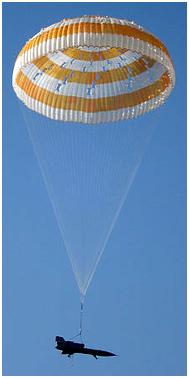 It was jettisoned when a larger brake chute located inside the large fairing at the rear above the engine nozzle was in turn deployed above the Tu-143 (picture opposite).
The landing gear as well as impact probes could then extend. When these touched the ground, a retrorocket located under the parachute was fired, reducing the vertical speed from 6m/sec to 2m/sec.
At the moment of touchdown, the parachute and its rocket were ejected, triggered by the compression of the landing gear oleo leg, to prevent the aircraft from being blown over by a wind gust
(> Video). A TZM-143 truck equipped with an articulated arm was dispatched to recover the drone once it had landed.
It was jettisoned when a larger brake chute located inside the large fairing at the rear above the engine nozzle was in turn deployed above the Tu-143 (picture opposite).
The landing gear as well as impact probes could then extend. When these touched the ground, a retrorocket located under the parachute was fired, reducing the vertical speed from 6m/sec to 2m/sec.
At the moment of touchdown, the parachute and its rocket were ejected, triggered by the compression of the landing gear oleo leg, to prevent the aircraft from being blown over by a wind gust
(> Video). A TZM-143 truck equipped with an articulated arm was dispatched to recover the drone once it had landed.
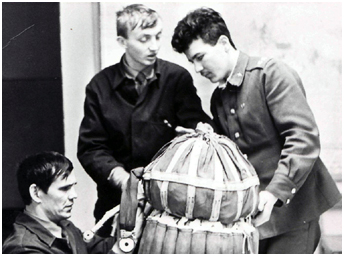 Préparation des parachutes.
Préparation des parachutes.
Parachute preparation.
In principle, a Tu-143 would be able to fly a new mission after four hours, provided of course that it had not suffered any damage. Once ready,
a Tu-143 could take off within 15 minutes. The lifespan of an aircraft was estimated at five missions. Then it was overhauled or withdrawn from service.
To overcome the contingencies and speed up the recovery process if the drone landed outside the squadron area, the possibility of bringing the drone back by Mi-8T helicopter had been envisioned
and put into practice at least in the USSR. An MRP-56 radio beacon was mounted on the drone for this purpose. The transport of the Tu-143 was obviously done under sling at a speed of 140 km/h under a
15-meter cable or at 200 km/h if the length was reduced to 5 meters. A small parachute was likely to be attached to the tail of the drone for stabilization purposes.
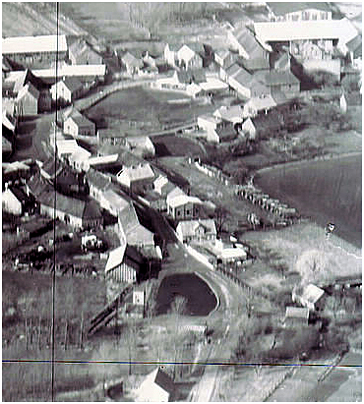 Un village de RDA vu depuis un Tu-143.
Un village de RDA vu depuis un Tu-143.
An East German village seen from a Tu-143.
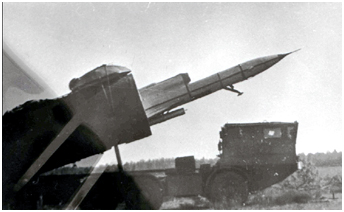 While the VR-3 complex was used by different branches of the Soviet armed forces, the units implementing it were originally subordinate to the VVS,
thus to the 16.VA in the GDR - at least when the "Reys" reconnaissance system entered service within the GSFG. Some squadrons destined to join the GDR (269. and 270.OEBSR - most probably the other units as
well) were established in Martsiena - near Madona - in Latvia where the 924th Combat Employment and Conversion Center for Unmanned Aircraft Unit Personnel
(Tsentr Boevogo Primeneniya i Pereuchivaniya Lichnogo Sostava Chastey Bespilotnikh Samoletov) was located. This unit controlled the 14th Separate UAV Research and Instructor Squadron
(OIIE BSR - Otdel'naya Issledovatel'sko-Instruktorskaya Eskadril'ya Bespilotnikh Letatel'nikh Apparatov) responsible for the VR-2 systems and the 275.OIIE BSR responsible for the
VR-3 systems. The squadrons were subordinated to the ground armies in 1979-80. Each Army had a small section responsible for the management of its air elements
(UAA - Upravlenie Armiya Aviatsii). Eventually, the OEBSR found themselves again under the VVS command in the spring of 1988.
While the VR-3 complex was used by different branches of the Soviet armed forces, the units implementing it were originally subordinate to the VVS,
thus to the 16.VA in the GDR - at least when the "Reys" reconnaissance system entered service within the GSFG. Some squadrons destined to join the GDR (269. and 270.OEBSR - most probably the other units as
well) were established in Martsiena - near Madona - in Latvia where the 924th Combat Employment and Conversion Center for Unmanned Aircraft Unit Personnel
(Tsentr Boevogo Primeneniya i Pereuchivaniya Lichnogo Sostava Chastey Bespilotnikh Samoletov) was located. This unit controlled the 14th Separate UAV Research and Instructor Squadron
(OIIE BSR - Otdel'naya Issledovatel'sko-Instruktorskaya Eskadril'ya Bespilotnikh Letatel'nikh Apparatov) responsible for the VR-2 systems and the 275.OIIE BSR responsible for the
VR-3 systems. The squadrons were subordinated to the ground armies in 1979-80. Each Army had a small section responsible for the management of its air elements
(UAA - Upravlenie Armiya Aviatsii). Eventually, the OEBSR found themselves again under the VVS command in the spring of 1988.
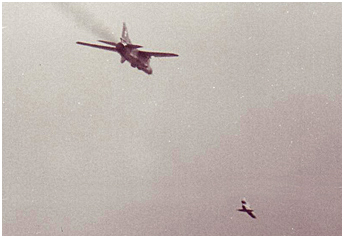
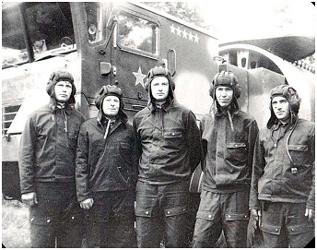 According to a testimony posted on a Russian forum, all BPLA units (Bespilotniy Letatelniy Apparat - unmanned aerial vehicles)
were deployed at the same time twice a year on the Wittstock training range.
This is where observations of Tu-143 are reported in the USMLM Annual report for 1983. The 1984 history mentions that the MMFL
photographed drones several times at Wittstock that year. Insofar as the photo opposite to the right is of French origin (although it may have been taken by another military liaison mission), it may be
one of a series. However, the vehicles of these units were observed on various training ranges such as Magdeburg (Letzlinger Heide) and Redlin.
Given the small size of the GDR that also included West Berlin in its centre, the Tu-143s were generally shadowed by fighters responsible for shooting them down in the event of loss of control.
Also, according to a testimony, a drone from the 269.OEBSR equipped with a TV reconnaissance suite was nevertheless lost in 1986 in the Müritzsee, near Lärz.
But the biennial deployment to Wittstock was probably not a systematic rule, because the units also exercised on ranges located in the USSR, such
as Kapustin Yar, Mary (Dzhebel - Turkmenistan) or Chimkent (Kazakhstan).
The number of annual flight hours for this type of unit was apparently very low, on the order of 2 to 3 hours.
According to a testimony posted on a Russian forum, all BPLA units (Bespilotniy Letatelniy Apparat - unmanned aerial vehicles)
were deployed at the same time twice a year on the Wittstock training range.
This is where observations of Tu-143 are reported in the USMLM Annual report for 1983. The 1984 history mentions that the MMFL
photographed drones several times at Wittstock that year. Insofar as the photo opposite to the right is of French origin (although it may have been taken by another military liaison mission), it may be
one of a series. However, the vehicles of these units were observed on various training ranges such as Magdeburg (Letzlinger Heide) and Redlin.
Given the small size of the GDR that also included West Berlin in its centre, the Tu-143s were generally shadowed by fighters responsible for shooting them down in the event of loss of control.
Also, according to a testimony, a drone from the 269.OEBSR equipped with a TV reconnaissance suite was nevertheless lost in 1986 in the Müritzsee, near Lärz.
But the biennial deployment to Wittstock was probably not a systematic rule, because the units also exercised on ranges located in the USSR, such
as Kapustin Yar, Mary (Dzhebel - Turkmenistan) or Chimkent (Kazakhstan).
The number of annual flight hours for this type of unit was apparently very low, on the order of 2 to 3 hours.
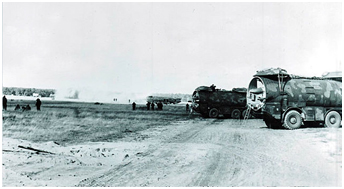
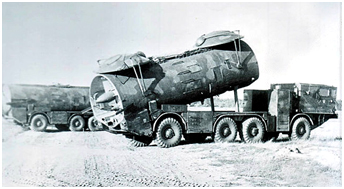 Out of 24 "Reys" squadrons, 17 were disbanded in 1989. With the return of these units under army control soon after and despite the need to keep more of this unit type
active, times were no longer favorable for such an evolution and 70% of the workforce fell by the wayside (> Link to vehicle storage).
The Tu-143s carried on flying for a long time in different contexts. The M-143 (VR-3VM system), a target version of the Tu-143 that entered service in 1985,
continued to serve as a target for surface-to-air missiles (1) .
Others - unless they were Tu-143? - ended their career as targets for fighter aviation, especially in Ukraine, as some
videos attest: > Link 1 / > Link 2. (2).
More recently, some Ukrainian Tu-143s were employed during the Donbass War.
Out of 24 "Reys" squadrons, 17 were disbanded in 1989. With the return of these units under army control soon after and despite the need to keep more of this unit type
active, times were no longer favorable for such an evolution and 70% of the workforce fell by the wayside (> Link to vehicle storage).
The Tu-143s carried on flying for a long time in different contexts. The M-143 (VR-3VM system), a target version of the Tu-143 that entered service in 1985,
continued to serve as a target for surface-to-air missiles (1) .
Others - unless they were Tu-143? - ended their career as targets for fighter aviation, especially in Ukraine, as some
videos attest: > Link 1 / > Link 2. (2).
More recently, some Ukrainian Tu-143s were employed during the Donbass War.
| VR-3 Reys Units | |||||
|---|---|---|---|---|---|
| Unit | FPN | Formation | Subordination | Base | Remarks |
| 265.OEBSR | 45314 | 1977-78 | 16.VA (until 1980) | Stendal (until 1987) / Zerbst (1987 - 1990) | moved to Zerbst in 1988 following formation of the 440.ovp BU |
| 1406.UAA, 3.OA (Magdebourg) (1980 - 04/1988) | |||||
| 16.VA (04/1988 - 1990) | |||||
| 268.OEBSR | 38361 | 1977-78 | 16.VA (until 1980) | Nohra (1978 - 1990) | |
| 1407.UAA, 8.GvOA (Nohra) (1980 - 04/1988) | |||||
| 16.VA (04/1988 - 1990) | |||||
| 269.OEBSR | 38676 | 1977 à Martsiena (Latvia) | 16.VA (until 1980) | Brandis (08/1977 - 1989) / Dresden-Heller (1989 - 1990) | moved to Dresden-Heller in 1989 following formation of the 485.ovp BU |
| 1409.UAA, 1.GvTA (Dresden) (1980 - 04/1988) | |||||
| 16.VA (04/1988 - 1990) | |||||
| 270.OEBSR | 38706 | 1977-78 à Martsiena (Latvia) | 16.VA (until 1980) | Parchim (1978 - 1990) | |
| 1410.UAA, 2.GvTA (Fürstenberg) (1980 - 04/1988) | |||||
| 16.VA (04/1988 - 1990) | |||||
| 290.OEBSR | 05040 | 1977-78 | 16.VA (until 1980) | Kietz (until 11/1989) / Prenzlau (01/12/89) | moved to Prenzlau after establishing the 487.ovp BU on this new airfield was abandoned |
| 1408.UAA, 20.GvOA (Eberswalde) (1980 - 04/1988) | |||||
| 16.VA (04/1988 - 1990) | |||||
Versions, derivatives and cousins
- In addition to the M-143 target drone mentioned at the end of the article, another derivative of the Tu-143 simply called "143" was a version intended to drop leaflets. A total of 19kg of material could fit in
the nose specially adapted for this particular mission, the release being done in block or in sequence.
- You would think that the Tu-141 - VR-2 Strij (Swallow) system - was the predecessor of the Tu-143, but it was not. Its first flight dates back to 1974. The airframe was reminiscent of the Tu-143, but it
was larger, and its range reached up to 950km. The employment of this drone, built in 152 units, was very similar to that of the Tu-143. However, because of its
larger in size and weight, its launch pad was mounted on a trailer. There also was a M-141 target variant.
- A more efficient version of the Tu-143 designated Tu-243 (VR-3D "Reys-D" system) made its first flight in 1987 and officially entered service in 1995. The fuel capacity had been increased to
give a range of 360km and the improved reconnaissance suite included an IR sensor, allowing it to operate day and night. The "Reis-DM" target version was also derived. The
latter also benefitted from an improved flight control system with the ability to change altitude fifteen times and turn twenty times. Apart from a small alteration of the nose cone, the airframe
of the Tu-243 remained the same, giving rise to numerous identification errors.
notes
(1)
On October 4, 2011, a Sibir Airlines Tu-154M connecting Tel Aviv to Novosibirsk was shot down by a 5V28 missile from an S-200V battery (> Link)
over the Black Sea at 11,000 meters. While the circumstances of the accident are controversial, we will note that the then ongoing Russian-Ukrainian air defense exercise made use of one or more Tu-143s
or more likely their target version M-143 (> Link).
(2)
In 2009, around fifty Ukrainian Tu-143s were sold to the Belspetsvnechtekhnika Company in Minsk, Belarus (> Link) where they were modified into
target drones to then be sold in Syria (> Link).
 |
Plan du site - Sitemap |  |
